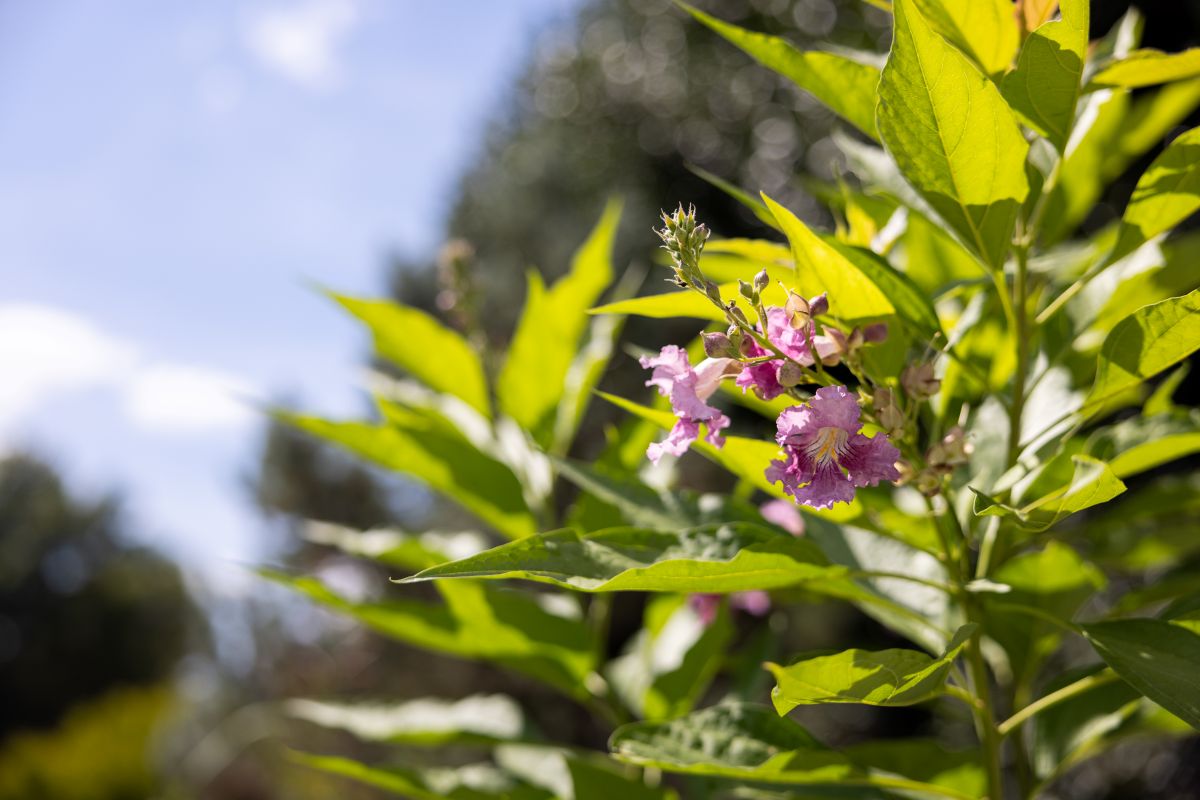
UT Gardens’ September Plant of the Month
Submitted by Jason Reeves, research associate, UT Gardens, Jackson
KNOXVILLE, Tenn. – It’s not too often you come across plants in the landscape that originate from two different genera. These are referred to as intergeneric hybrids. Perhaps the most common is Leyland cypress, a hybrid between Cupressus and Chamaecyparis. There are others, including a hybrid between Hedera helix and Fatsia japonica that combine to make x Fatshedera and x Gordlinia grandiflora from Franklinia alatamaha and Gordonia lasianthus.
In the 1960s, a cross was made between two U.S. native trees in the Bignoniacea family, northern catalpa (Catalpa bignoniodes) and desert willow (Chilopsis linearis). The combination of large growing, big leafed northern catalpa, (hardy to zone 4) and the much smaller growing, narrow-leafed desert willow (hardy zone 7) led to a small tree that proved to be hardy to zone 6 and was called x Chitalpa. Chitalpa grew vigorously in youth with a shrubby, loose, open habit and an abundance of flowers on new growth during the summer. The foliage was medium in size but highly susceptible to mildew, and overall, the hybrid did not measure up to other deciduous flowering shrubs and never became mainstream.
Fast forward 40 years to the North Carolina State University Mountain Crop Improvement Lab where they began breeding x Chitalpa to see if they could improve its landscape worthiness. As a graduate student working under Tom Ranney, Richard Owens, now the director of the U.S. Arboretum, initially led the efforts in creating these hybrids and screening them for powdery mildew resistance. Research continued at N.C. State for about two decades to find the best of these hybrids. After evaluating hundreds of x Chitalpa seedlings, one was finally selected for superior performance in 2023 and officially named El Niño.
El Niño produces showy clusters of fragrant, 1-inch-deep pink flowers that resemble orchids. It can grow as much as 6 to 8 feet in a growing season when it’s young with the estimated maturity being 18-20 feet. Potentially, it may top out somewhere closer to 30 feet. The leaves—2 to 3 inches wide and 4 to 6 inches long—have proven to be powdery mildew resistant, and like one of its parents, Catalpa, is a host for the catalpa worm, the caterpillar of the catalpa sphinx moth. Just like catalpa, El Niño recovers quickly from having its leaves eaten with new foliage with little to no effect on the plant’s health.
It makes an excellent multi-branched small tree or shrub. It grows and reblooms so quickly it can be pruned and kept smaller if desired. Pruning results in a full shrubbier form that continues to produce fragrant flowers all summer. It can also be treated completely as a cut-back shrub, cutting it to near the ground each spring. It is best grown with six or more hours of full sun, and like its parents, it is heat and drought tolerant and requires little care after establishment.
El Niño can be found growing at the UT Gardens, Jackson, in the “Mediterranean” bed and in the shrub bed near the flagpole in front of the main office building and at the UT Gardens, Knoxville, by the tool shed and in the purple and yellow garden.
The UT Gardens includes plant collections located in Knoxville, Crossville and Jackson, Tennessee. Designated as the official botanical garden for the State of Tennessee, the UT Gardens are part of the UT Institute of Agriculture. The Gardens’ mission is to foster appreciation, education and stewardship of plants through garden displays, educational programs and research trials. The Gardens are open during all seasons and free to the public. For more information, see the Gardens website: utgardens.tennessee.edu.
The University of Tennessee Institute of Agriculture is comprised of the Herbert College of Agriculture, UT College of Veterinary Medicine, UT AgResearch and UT Extension. Through its land-grant mission of teaching, research and outreach, the Institute touches lives and provides Real. Life. Solutions. to Tennesseans and beyond. utia.tennessee.edu.